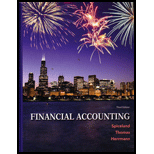
Concept explainers
(1)
Asset:
Assets refer to the resources owned by the business, which are utilized in the course of the business to generate revenue.
Liability:
Liabilities include the claims of the creditors on the assets of the business. The liability is the obligation of the business.
Stockholder’s equity:
Stockholder’s equity refers to the right the owner possesses over the resources of the business. Revenues and the expenses are the components of the owner’s equity.
Revenues:
Revenue refers to the income received from the business activity or sale of the output, during the accounting period.
Expenses:
Expenses refer to the cost incurred on the necessary purchases of the fixed assets by the firm, or the production of the goods and services, during the accounting period.
To Indicate: The type of account for each of the given accounts.
(2)
Normal balance:
Normal balance refers to the excess of amount on one side, over the amount on the other side in an account. The excess amount of debit side over the credit side is shown as the normal debit balance. The excess amount of credit side over the debit side is shown as the normal credit balance.
| Type of account | Normal balance |
| Asset account | Debit balance |
| Liability account | Credit balance |
| Expense account | Debit balance |
| Revenue account | Credit balance |
| Common stock account | Credit balance |
| Dividend account | Debit balance |
Table (2)
To Indicate: The type of account for each of the given accounts.
Want to see the full answer?
Check out a sample textbook solution
Chapter 2 Solutions
Financial Accounting
- What is ROE in 2008?arrow_forwardThe total cost of the units completed?arrow_forwardBlockbuster Co is building a new state of the art Cineplex at a cost of $3,500,000. They received a capital investment of $1,500,000. The remainder of funds will have to be borrowed so they decided to issue bonds. They have issued 10.5%, 5-year bonds. These bonds were issued on January 1st, 2020, and pay semi-annual interest on July 1st and January 1st. The bonds yield 10%. The year-end is December 31st. Requirements: (Show all workings) Calculate the proceeds from the sale of the bond. Clearly, show the amount of the premium or discount and state two reasons, which support the premium or discount calculated. Compute the Present Value of Interest Payments show all steps using the formula.arrow_forward
- Principles of Accounting Volume 1AccountingISBN:9781947172685Author:OpenStaxPublisher:OpenStax College
 Intermediate Accounting: Reporting And AnalysisAccountingISBN:9781337788281Author:James M. Wahlen, Jefferson P. Jones, Donald PagachPublisher:Cengage Learning
Intermediate Accounting: Reporting And AnalysisAccountingISBN:9781337788281Author:James M. Wahlen, Jefferson P. Jones, Donald PagachPublisher:Cengage Learning Financial Accounting: The Impact on Decision Make...AccountingISBN:9781305654174Author:Gary A. Porter, Curtis L. NortonPublisher:Cengage Learning
Financial Accounting: The Impact on Decision Make...AccountingISBN:9781305654174Author:Gary A. Porter, Curtis L. NortonPublisher:Cengage Learning - Century 21 Accounting Multicolumn JournalAccountingISBN:9781337679503Author:GilbertsonPublisher:Cengage



